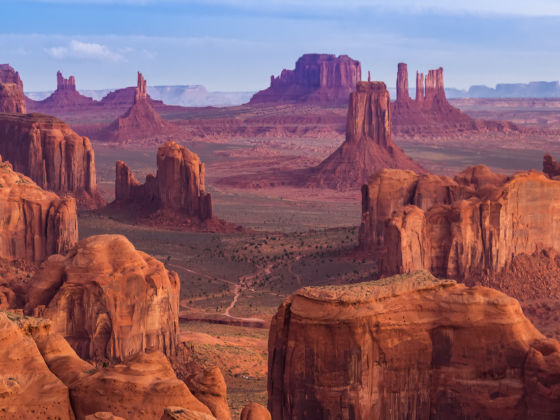1. There are no giant sand dunes in Arizona.
This is the Sonoran Desert, not the Sahara. And according to some climatologists, it’s the wettest desert in the world. Receiving between 3 and 20 inches of rain annually, the Sonoran is the ideal habitat for hundreds of bird varieties, 100 kinds of reptiles, and 2,000 species of plants. It’s also the only place on the planet where the iconic saguaro cactus grows.
2. Cutting down a saguaro is illegal.
Speaking of that iconic green giant with the humanoid arms, if you cut one down without a permit — whether on public or private land — you might have to pay a fine of up to $5,000. In some cases, it’ll be considered a felony…and you thought the needles hurt.
3. In Arizona, you can drive from Mexico to Canada in half an hour.
Well, you can drive the ecological equivalent. Just north of Tucson, the Catalina Highway climbs from the desert floor, around 2,500 feet above sea level, to about 9,000 feet. You’ll wind through saguaro-studded hills, semi-arid grassland, junipers, short oaks, and Ponderosa pines before finally ending up in a forest of aspens and Douglas firs. The Santa Catalina Mountains are one of several Arizonan Sky Islands — mountain ranges separated by lowland ‘seas’ of desert.
4. Oklahoma! was filmed here.
Yep. Aside from the studio shots in California, most of Oklahoma! was filmed in San Rafael Valley in the border country near Nogales. The wind comes sweeping down the desert plain…
5. The “Sunshine State” is a more accurate nickname for Arizona than Florida.
Meteorological statistics don’t lie. Arizona is the sunniest state in the country. (Florida comes in fifth.) Yuma is sunny 90% of the time, and Phoenix and Tucson tie at 85%. No city in Florida even makes the top ten.
6. This is one of the oldest continuously farmed regions on the continent.
The Santa Cruz Valley, stretching northward from the border near Nogales up to Tucson, has been farmed since at least 2000 BCE. Around Phoenix, some of the modern canals follow the same paths that pre-Columbian engineers excavated a millennium ago. Heirloom varieties of maize, squash, and beans, along with mesquite flour and prickly pear fruit, can still be planted, harvested, and eaten today. The farm-to-table movement is alive and well in Arizona.
7. There’s wine country here. No, really.
Sonoita, Wilcox, and the Verde Valley between Sedona and Jerome have soil and climate conditions similar to those in parts of the south of France, Spain, and Southeastern Australia. For decades, vintners here have been harvesting the alchemy of sun and terroir.
8. The chimichanga was invented here, not in Mexico.
That deep-fried and celebratory staple of Mexican restaurants across America was invented here, in Tucson. The legendary Monica Flin of El Charro Café — the nation’s oldest continuously run family Mexican restaurant — dropped a “burro” into a large vat of boiling fat by accident. To avoid exposing the ears of nearby children to vulgarity, she transformed the final syllable of a commonly used Mexican curse word into the innocently musical chimichanga. Taste buds have been trumping arteries ever since.
9. Arizona is home to the only venomous lizard in the U.S.
Gila monsters are a protected species, and seeing one of these orange-and-black herptiles is a treat as they’re highly elusive. Don’t panic if you do cross paths — they don’t attack, only chomping down on those who choose to harass them.
10. The southernmost ski run in the country is in Arizona.
Near Tucson, on the summit of Mount Lemmon (9,157 feet above sea level), Ski Valley is the southernmost ski run in the United States. Only 1.5 hours north of the Mexican border, on average this mountain receives 180 inches of snow per year. The lift operates in summer as well. Floating among cool evergreens while gazing at the hot desert some 6,500 feet below is a novel experience, to say the least.
11. It’s perhaps the world’s unlikeliest jaguar habitat.
Jaguars? Like, the king of the South American jungle? That’s right — they rove as far as Arizona, which is the northern limit of their habitat. As recently as the 1960s, jaguars were spotted near the Grand Canyon. Today they still roam the Santa Rita Mountains and San Pedro Valley of Southeast Arizona.
12. The sun doesn’t get any bigger than it does here.
Amid the forest of astronomical observatories on the top of Kitt Peak, you’ll find the world’s largest solar telescope. Its 110-foot tower focuses sunlight down a 200-foot-long diagonal light shaft that extends 50 vertical meters into the mountain, reflecting off a series of mirrors to give an 85-centimeter-wide image of the sun.
13. It’s home to the world’s oldest rodeos.
Prescott, northwest of Phoenix, is home to the world’s oldest rodeo. And a couple hours’ drive away, Payson is home to the world’s oldest continuously operating rodeo. They’ve both been lassoing since the 1880s.
14. It’s a state of many nations.
Native American nations, that is — the 22 sovereign Indian nations cover a quarter of the state’s land area. No other state is as ‘native’ as Arizona. And, after English and Spanish, the Navajo language is the most widely spoken in the state.
15. Your right to remain silent began here.
You know, from crime shows, that phrase “you have the right to remain silent?” The Miranda rule owes its origins to a crime in Phoenix and the subsequent U.S. Supreme Court case — Miranda vs. Arizona — from the 1960s.
16. Arizona has its own Mesoamerican ballcourts.
Archaeologists have found numerous ballcourts throughout the state. The pre-Columbian cultures in the desert Southwest had trade networks that reached all the way down into the tropics. Macaws — transported alive — may have parroted the words of long-disappeared languages that once echoed among the adobe walls.
17. It’s one of the country’s top producers of nuts.
Want some pecans? You don’t have to go to Georgia or Texas. Arizona is one of the nation’s top producers of the tree-grown treat. Green Valley Pecan Company manages 7,000 acres. And over in Cochise County, Fistiki Farms grows pistachios. If you want to pick your own, here’s a good resource.
18. It’s a hummingbird paradise.
These diminutive aerial acrobats love this state. Seventeen different species have been recorded in Arizona, more than in any other state except for Texas. In some canyons, spotters have seen 14 different varieties in just one day.
19. Hawks love it here too. And they hunt…in packs.
Harris hawks, usually associated with their more tropical habitat, have made themselves at home here in Arizona. And these raptors have adapted in a unique way — only in Arizona have they been observed hunting cooperatively, as family groups, in packs…like wolves!
20. The world’s first McDonald’s drive-thru was installed here.
In 1975, soldiers from Fort Huachuca were finally able to rush off base and get a Big Mac on their lunch hour. At the time, they weren’t allowed to leave their vehicles while wearing fatigues, so, at 1802 Fry Boulevard, the McDonald’s in Sierra Vista figured out a way to purvey fried food while respecting uniform rules. Billions have been lovin’ it ever since.

